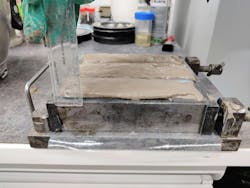Finnish researchers bind brine wastewater into concrete
(University of Oulu release) — Industrial and mining brine wastewaters could be mixed into an alternative cementitous binder with sufficient strength for a variety of applications, including mine backfilling. This would allow highly concentrated salt waters to be safely bound into solid form, while saving the environment and costs.
Several industrial sectors required by the green and digital transition, such as battery production, mining or ash processing, generate high levels of saline wastewaters. Sodium, sulphate and chloride are usually the main components of these effluents. Such salts are not toxic or harmful as such to the environment — the same salts are present in seawater. However, they can cause problems for biota in the low-salinity Baltic Sea but especially in inland freshwaters. For example, after the Talvivaara mining accident in Finland (2012), salt-contaminated lakes were found to be permanently stratified, which can cause oxygen deficiency in the lake bottom.
In a new treatment method developed at the University of Oulu, concentrated brines can be stabilized using so-called alkali activation, which combines brines as a part of cementitious binder. The method, developed by researcher Sima Kamali in her doctoral thesis, mixes a calcium-, silicon- and aluminum-rich raw material with brine and a small amount of sodium hydroxide. The end result is a paste that can be used as a concrete binder, as it achieves sufficient strength for a variety of applications.
This method was examined in a recent study using slag from the metal industry as a raw material. The study found that the main components of concentrated brine — sodium, sulphate and chloride — were stabilized in the solid structure particularly well and were no longer soluble in water. Another surprising result of the study was that a high salt content improved the properties of the alkali-activated paste, such as strength. The limitation, however, is that conventional steel reinforcement cannot be used in this type of concrete due to the risk of corrosion caused by salt.
"The developed method could be of particular interest in mining environments, where the raw material for the stabilization could be mine tailings," suggests Tero Luukkonen, associate professor at the University of Oulu. Mine tailings are the waste material left over after valuable ores have been extracted from a mine. The tailings are stored in tailings ponds. "Often, tailings contain large amounts of calcium, silicon and aluminum, which are precisely the elements needed for alkali activation," says Luukkonen.
"The new method could therefore combine two challenging waste streams: mine brines and tailings, to produce a useful material for applications such as mine filling. At present, ordinary Portland cement is often used in mine fillings, which could be replaced by an alkali-activated material," says Kamali.
There is growing interest in the use of tailings in the construction and concrete industries, and the University of Oulu is carrying out a wide range of research into new materials and the purification of mine water. However, the use of mine wastewater as a raw material is a novel approach.
The new research results were produced as part of a research project KaiPa (read more in Finnish), which is co-funded by the European Union (under the NextGeneration EU programme). The results were published in the journal Desalination on October 1, 2024: Reverse osmosis reject water management by immobilization into alkali-activated materials.
